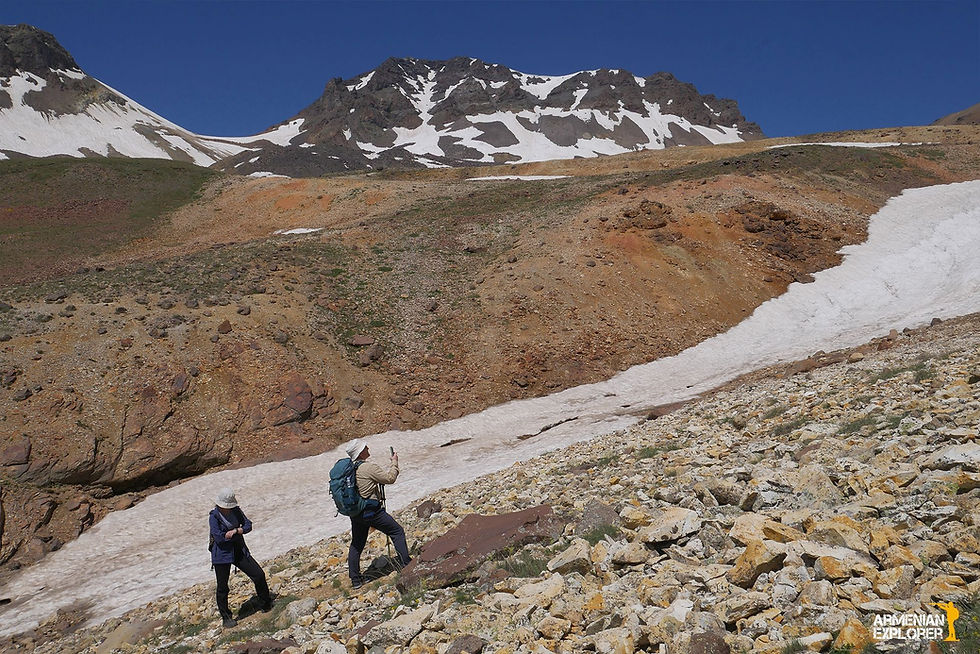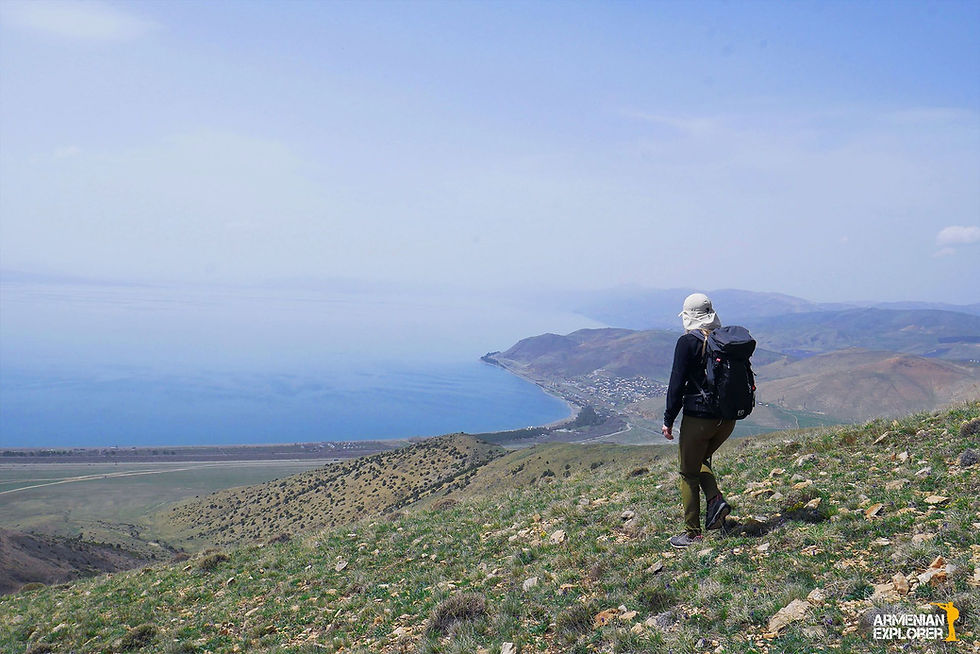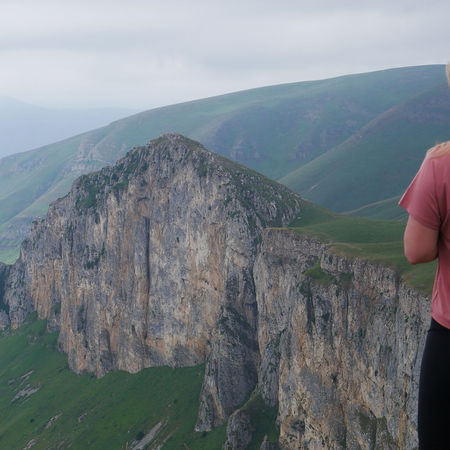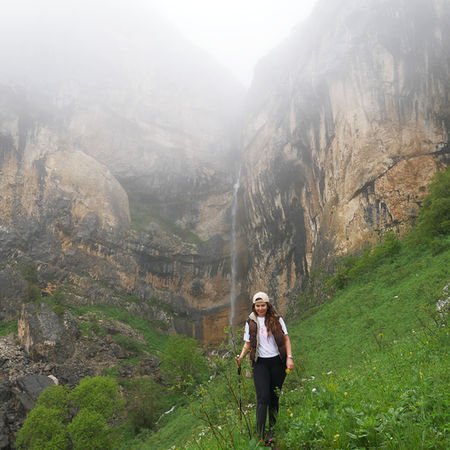

Гид по Армении (русскоговорящий с автомобилем)
Я — Сурен, ваш гид по Армении (русскоговорящий, с автомобилем). В этой статье я расскажу немного о себе и своих услугах, а также поделюсь практическими советами для тех, кто планирует поездку по Армении. Моя специализация — урбекс, пешие походы, внедорожные туры и экскурсии по достопримечательностям, и именно на этом мы сосредоточимся. Советы, которыми я делюсь, основаны как на моем личном опыте, так и на ценнейших отзывах путешественников, которых я уже сопровождал. Доверяйте мне — я знаю дорогу.
О себе…
Меня зовут Сурен, я профессиональный гид по Армении. Многие путешественники ищут гида, который также предоставляет транспорт — и да, я сам за рулем. Моя задача — сделать ваше путешествие удобным, запоминающимся и экономичным. (Фото и подробности ниже.)
С 2014 года я сопровождаю туристов по всей Армении — от легких пеших маршрутов до сложных горных восхождений, удаленных внедорожных троп и исследований заброшенных объектов. За это время я накопил глубокие знания и практический опыт, которыми охотно делюсь с каждым, кто планирует поход или экскурсию по стране. Во время туров я беру с собой фотоальбом с историческими снимками, чтобы показать, как выглядели достопримечательности до реставрации или даже до их исчезновения.
Завязывайте ботинки — вперед к новым приключениям!

Да, это я позирую для фото в священной долине Тиринкатар, рядом с армянским вишапом — древним «камнем-драконом»!
Во время моей работы фриланс-гидом для различных туристических агентств я заметил, что многие путешественники сталкиваются с трудностями при попытке напрямую связаться с местными гидами. Когда я запустил свой сайт, моя цель была облегчить путешественникам возможность напрямую общаться с гидом — обсуждать предстоящие поездки, индивидуально корректировать маршруты и понять, подходит ли им этот гид для их отдыха. В конце концов, именно гид — а не туристическое агентство — делится с путешественниками и трудностями, и радостями путешествия.

Мой автомобиль, Mitsubishi Pajero 4, — надежная рабочая лошадка, созданная для сложного бездорожья и чтобы каждая экскурсия проходила максимально комфортно и эффективно.
И здесь на сцену выходит Armenian Explorer — чтобы сделать эту связь возможной. Надеюсь, эта статья поможет большему числу путешественников найти меня и повысит мою видимость в поисковых системах.
Мой диплом магистра по сравнительной литературе позволяет мне получать и анализировать широкий спектр исторической информации об Армении, чтобы делиться ею с путешественниками и рассказывать увлекательные истории, стоящие за каждым уникальным местом, которое мы посещаем. Экскурсии проводятся на английском или русском языках, также у меня есть базовое знание немецкого.

На берегу озера Кари (3 200 м), сделав памятное фото с группой из Сингапура, я проведу их к вершине южного пика горы Арагац.
Сейчас я предоставлю краткую пошаговую информацию о самых популярных туристических направлениях в Армении. Начнём с пеших походов.
Армения — настоящий рай для любителей хайкинга. В стране есть маршруты на любой уровень подготовки — от лёгких прогулок по лесу до сложных восхождений выше 3 000 метров.
Зимой мы обычно избегаем пиков выше 3 000 метров из-за глубокого снега и грязи, которые делают походы и внедорожные поездки невозможными.
С июня до конца октября условия улучшаются; на низких высотах может быть довольно жарко, что делает этот период лучшим для покорения вершин выше 3 000 метров.
Гора Аждаак
Один из самых популярных маршрутов для хайкинга в Армении — гора Аждаак (3 597 м), высшая точка хребта Гегамских гор. «Красный гигант» знаменит своим вулканическим озером на высоте 3 500 метров и панорамными видами на озеро Севан, озеро Акна и окружающие вершины, такие как Красный Хребет и Спитакасар.
Да, в кратерном озере можно плавать, поэтому не забудьте купальный костюм. Учтите, однако, что вода очень холодная — около 10°C даже в самые жаркие летние дни — а дно озера усеяно острыми камнями. Купание в глубоких зонах крайне не рекомендуется.

Классический маршрут начинается у подножия горы Пайтасар, но для начинающих туристов я часто подъезжаю ближе к подножию Аждаака, оставляя всего около 50 минут пешего пути до вершины. Озеро Акна, озеро Бади и Озеро Дракон — одни из самых популярных мест для кемпинга в этом районе, о которых мы расскажем позже.
Гегамские горы прекрасно подходят не только для однодневных походов, но и для многодневных треккингов и походов с ночёвкой, которые я регулярно включаю в свои туры.

Краткая остановка у Гегамских петроглифов для изучения этих древних наскальных изображений.
Важно! За годы работы я встречал множество туристов, которые пытались добраться до горы Аждаак на арендованном кроссовере, но возвращались обратно, когда обнаруживали, что местность слишком каменистая и опасная для таких автомобилей. Вам понадобится мощный автомобиль с высоким клиренсом, хорошие навыки вождения и навигации, а также умение справляться с неожиданными трудностями. Обычно грязь не представляет проблемы — застрять не удастся, — но скользкие склоны встречаются часто, а в дождливые дни маршрут становится особенно сложным.
Начать треккинг от деревни Гегард пешком может быть довольно сложно, особенно если вы не знаете местоположение родников. Если вы не опытный турист с хорошими навыками чтения карт и навигации, лучше нанять гида.
В Гегамских горах вы окажетесь в полной дикой природе, поэтому не рассчитывайте на наличие туалета.
Гора Арагац — Крыша Армении
Ещё одна обязательная для посещения точка для пеших походов — гора Арагац (4 090 м), самая высокая вершина Армении, с четырьмя ярко выраженными пиками:
Северный пик — 4 090 м (самая высокая точка Армении)
Западный пик — 3 995 м
Восточный пик — 3 908 м
Южный пик — 3 888 м

Существует два основных пункта старта для восхождения на Арагац — озеро Кари (3 200 м) и водопад Гегарот (3 000 м).
Lake Kari is easily accessible by car thanks to an old asphalt road built during Soviet times, more than half a century ago, to allow scientists to reach the Cosmic Ray Research Station. It also serves as a convenient base for climbing all four peaks of Mount Aragats. However, the road is open only from mid-May to the end of October. On the shore of Lake Kari, there is a restaurant and a hotel, but don’t expect to use their toilets. You will need to rely on an open-air toilet—beware of this.

В конце октября 2025 года мы застряли в глубоком снегу, так как эта местность сильно подвержена сильным ветрам и метелям, которые часто перекрывают дорогу. К счастью, пока мы наслаждались чашкой кофе, подъехал бульдозер и расчистил путь.
Gegharot Waterfall offers a shorter route to the northern and eastern summits but requires a high-clearance off-road vehicle to reach. Keep in mind that the road to Gegharot is just as rough as the one to Mount Azhdahak — a sturdy vehicle is a must. Last time I was there, I saw dozens of cars abandoned along the way; their drivers realized too late that the rocky terrain would destroy their plastic crossovers, so they gave up on climbing Aragats and were lucky just to make it as far as the waterfall.
In this area, you are already far from any civilization—only tourists and shepherds may be encountered here. There are no toilets and no tourist infrastructure. Wild Armenia welcomes you!

We have just reached the crater of mount Aragats and are ready for the final summit push!
If you’re fit and up for a challenge, you can conquer two peaks in a single day — usually the Southern and Western summits. For a more immersive experience, consider a two-day trek: start from Lake Kari, climb the first two peaks, camp overnight inside Aragats’ massive crater, and the next day, ascend the Northern and Eastern summits before descending to Gegharot waterfall, where an off-road car can meet you.
Winter and Easy Hikes in Armenia
In winter, I recommend hikes to Lastiver, the Lake Parz–Goshavank trail, Smbataberd (Fortress of Smbat), or a climb to Mount Artanish.
The summit of Mount Artanish is the only point from where you can see the entire Lake Sevan from above — a view that’s truly unforgettable. Located in the Gegharkunik region, on the eastern shore of Lake Sevan, the mountain stands on the Artanish Peninsula, which separates Big and Small Sevan. Rising to 2,460 meters above sea level with a relative height of 560 meters, this hike covers about 5 km one way, takes around 2.5 hours, and involves an elevation gain of 560 meters.

Descending from mount Artanish!
Lastiver is home to a two-story cave carved into a steep canyon slope near the majestic gorge of the Khachaghbyur River. Surrounded by towering trees, rugged cliffs, and the soothing sound of the river, this place feels like stepping into a fairy tale.

In the 1970s, Soviet-Armenian sculptor Benik Petrosyan decorated the cave walls with striking bas-reliefs, enhancing its mysterious aura. Many visitors mistakenly believe these carvings are ancient, which only adds to the sense of wonder.
Historically, the caves of Lastiver served as a refuge for locals during the Mongol invasions of the 13th and 14th centuries. To reach the caves, people built wooden staircases resembling rafts — which is how the site got its name, “Lastiver,” derived from Armenian.
The hike to Lastiver covers about 3.5 km one way, takes roughly 2 hours, and starts about 145 km from Yerevan.

It was a rainy day when we started our hike to Lastiver!
For a scenic two-day trek, the Lori region is one of my favorites. The Lori Canyon provides breathtaking views, and along the way, you can visit several UNESCO World Heritage Sites — a perfect mix of nature and culture.
A hike along Lori Canyon to Horomayr Monastery or to Kayan Fortress is something you’ll love. Unlike the Gegharkunik or Aragatsotn regions, this area is covered with thick forests—if you appreciate that, this region is perfect for you.

The lovely Lori Kanyon
Sightseeing tours in Armenia
The most popular sightseeing tours in Armenia include Echmiadzin Cathedral, Garni Pagan Temple, Geghard Monastery, and Sevanavank. These sites are not only historically and architecturally significant but also conveniently located near Yerevan, making them must-visit destinations. For travelers with more time, Haghpat and Sanahin, both UNESCO World Heritage sites, are essential stops. Other highly recommended destinations include Khor Virap, Noravank, and Tatev Monastery. Here’s a brief overview of these remarkable locations.

Etchmiadzin Cathedral is the mother church of the Armenian Apostolic Church, located in the city known both as Etchmiadzin (Ejmiatsin) and Vagharshapat, Armenia. It is widely recognized as the first cathedral built in ancient Armenia and is often regarded as the oldest Christian cathedral in the world.
Garni Pagan Temple & Geghard Monastery Tour
The Garni-Geghard tour is one of Armenia’s most popular sightseeing experiences, offering a journey from ancient pagan traditions to the dawn of Christianity. Located just a short drive from Yerevan, these landmarks offer an excellent opportunity to explore Armenia’s rich cultural and historical heritage within a few hours. Moreover, thanks to their close proximity, even private tours here are quite budget-friendly.

Garni Pagan Temple, built in the 1st century AD during the reign of King Tiridates I, is the only surviving Greco-Roman colonnaded temple in the post-Soviet region. Dedicated to Mihr, the Armenian sun god, it endured centuries of history, including Armenia’s conversion to Christianity in 301 AD. Destroyed by an earthquake in 1679, it was meticulously restored in the 1970s. Today, Garni stands as a rare testament to Armenia’s pre-Christian heritage. On the territory of Garni Fortress, a free toilet is available.

Geghard Monastery, a UNESCO World Heritage site in Kotayk Province, dates back to the 4th century and was founded by St. Gregory the Illuminator. Its name, meaning “Monastery of the Spear,” comes from the Holy Lance—the relic believed to have pierced Jesus Christ’s side during the crucifixion, brought to Armenia by the Apostle Thaddeus. While the relic is now kept in the Treasury of Etchmiadzin, Geghard remains a stunning example of rock-hewn Armenian architecture and spiritual significance. Near Geghard Monastery, a paid toilet is available for just 100 AMD.
Khor Virap Monastery, set against the majestic backdrop of Mount Ararat, is one of Armenia’s most sacred pilgrimage sites. It marks the 13-year imprisonment of Gregory the Illuminator by King Tiridates III, after which Gregory became the king’s religious mentor, leading Armenia to become the world’s first Christian nation in 301 AD.

The first chapel at Khor Virap was built in 642 by Nerses III the Builder to honor Saint Gregory. Over the centuries, it underwent several reconstructions, and in 1662 the larger St. Astvatsatsin (Holy Mother of God) chapel was built around the original structure, incorporating the monastery, refectory, and monks’ cells.

Noravank, a 13th-century Armenian monastic complex, is famed for its Surb Astvatsatsin (Holy Mother of God) and Surb Karapet (St. John the Baptist) churches. Nestled in a gorge of striking red cliffs, it is one of Armenia’s most photogenic and popular tourist destinations.

Sevanavank is a 9th-century monastic complex located on a peninsula of Lake Sevan in the Gegharkunik Province of Armenia. The complex consists of two churches: Surb Arakelots (“Holy Apostles”) and Surb Astvatsatsin (“Holy Mother of God”), both built with cruciform plans and octagonal tambours.

Монастыри Санаин и Ахпат, оба включённые в список Всемирного наследия ЮНЕСКО, представляют собой не только выдающиеся образцы средневековой армянской архитектуры, но и знаковые кинематографические локации. Здесь были сняты сцены из культового фильма Сергея Параджанова «Цвет граната» (1969), что придаёт этим и без того величественным монастырским комплексам дополнительную художественную и культурную ценность.
Urbex tours in Armenia
After the collapse of the Soviet Union, many industrial plants, hotels, pioneer camps, culture houses, cable car stations, and other facilities were abandoned, looted, or fell into decay. Over time, these sites have gained a mysterious and captivating atmosphere, attracting travelers fascinated by urbex and abandoned places. Today, they are highly sought-after by urban explorers, and the private guided tours I offer attract hundreds of tourists each year. Here are a few of the remarkable urbex destinations where I personally guide my clients.

Hidden in the serene hills of Orgov lies ROT54, a massive, now-abandoned scientific telescope. Built between 1975 and 1985, it features a 54-meter (177 ft) dish and was once among the world’s most advanced radio-optical telescopes. The project was conceived by Paris Herouni, an Armenian radio astronomer, physicist, and engineer, who spent years persuading Soviet authorities to approve its construction in Armenia.

The control room of ROT54
The telescope operated from 1986 until 1990. In the mid-1990s, restoration efforts began: between 1995 and 2010, it was partially modernized with new control systems and equipment, allowing observations to resume with support from the Astronomical Society of Russia and the National Technical University of Athens. However, in 2012, a control arm failed, disabling the secondary mirror and halting operations once again. With no funds available for repairs, the facility was ultimately mothballed.

Carlus from Spain is happy to finally visit this place
From my personal experience, I can tell you that this is one of the most popular destinations for urban explorers, and I often receive requests to take tourists here. A typical tour to ROT54, if we start early at around 7:50 AM from Yerevan, takes about four hours in total — we’re back in the city by midday. So even if you’re using Armenia as a transit stop or are short on time, this is a destination you shouldn’t miss before leaving.
The Trophy 1-Meter Schmidt Telescope — Hitler’s Gift to Mussolini
On the way to ROT54, we pass through the village of Byurakan, where in 1946 Viktor Hambardzumyan founded one of Armenia’s most renowned scientific centers — the Byurakan Observatory. Several telescopes here are open for visitors, but the one that draws the most attention is the legendary 1-meter Schmidt telescope.

This telescope carries significant historical value — it was originally a gift from Hitler to Mussolini, and its inauguration was attended by Soviet leader Nikita Khrushchev. Beyond its political past, it played a key role in major astronomical discoveries.

The building that houses the ZTA-2.6 telescope...
In 1965, Benjamin Markarian used the Schmidt telescope to conduct the First Byurakan Survey (FBS). Through these observations, he discovered numerous faint galaxies, from the 13th to 17th magnitude, notable for their excess ultraviolet radiation. These celestial bodies became known as Markarian galaxies in his honor.
Armenia’s Particle Accelerator
Just a short drive from central Yerevan, in what were once the city’s outskirts during the 1960s, stands something few would expect from a small mountainous country better known for its ancient monasteries and volcanic peaks — a particle accelerator.

Founded in 1943 as a branch of Yerevan State University by renowned physicists Abraham Alikhanov and Artem Alikhanyan, the Yerevan Physics Institute (YerPhI) soon became a cornerstone of Armenia’s scientific ambitions.
In 1965, the LU-75 linear accelerator was completed, and two years later it was joined by a 6 GeV synchrotron. Though its raw power could not match modern giants like CERN, this facility was once among the most advanced in the Soviet Union, operating for over 5,000 hours annually at its peak.

The “Arus” synchrotron — about 70 meters in diameter and 220 meters in circumference — was designed to accelerate electrons to 6 GeV. It also generated a beam of linearly polarized photons in the 0.9–1.8 GeV range, enabling high-precision experiments in particle physics and interactions.
Tours to an Abandoned Refractory Brick Factory
During my urbex tours, we also explore a massive Soviet-era refractory brick factory — a haunting reminder of Armenia’s industrial past.

Built in 1951, the factory was strategically positioned near a rich clay deposit, crucial for producing high-quality fire-resistant bricks. At its peak, it employed over 600 workers, forming the backbone of the local economy and sustaining nearby villages and towns. Every day, seven to eight railway wagons carried bricks to Russia, fueling the Soviet Union’s vast industrial demand.

Stepping inside today feels like entering a time capsule. Rusting machinery, heavy-duty tools, and even Soviet trucks remain scattered across the vast production halls. Strange metal devices — their purpose now forgotten — lie untouched, frozen in time as industrial relics of a vanished era.
The Iron Fountain in Gyumri
Despite being abandoned and surrounded by scattered debris, this rusty iron fountain in Gyumri continues to draw curious visitors from around the world — and it’s always on my must-see list when touring the city.

This post-apocalyptic masterpiece, officially named the “Friendship” Fountain but better known as “The Iron Fountain,” was designed by renowned Armenian architect Arthur Tarkhanyan. Inaugurated in 1982, it quickly became a favorite gathering place for locals, especially during evening walks.
Although the fountain itself survived the devastating 1988 earthquake, the surrounding area fell into neglect. The difficult post-earthquake years left little room for restoration, and the site has since remained a striking symbol of Gyumri’s resilience and faded Soviet grandeur.
Тур по заброшенной ковровой фабрике
Одна из самых впечатляющих точек моих урбекс-туров — эта заброшенная ковровая фабрика, огромный и молчаливый памятник промышленному наследию Армении.

Когда-то шумевший тысячами рабочих, этот гигантский завод мог выпускать до одного миллиона квадратных метров ковров ежегодно. Основанный в 1964 году, он специализировался на производстве различных типов ковров — включая двустенные, жаккардовые и пятитоновые изделия — из таких материалов, как новозеландская шерсть, отечественный капрон и медно-аммиачное волокно.

В 1975 году, на пике своей деятельности, фабрика достигла рекордных показателей производства и получила международное признание за красоту и мастерство своих ковров, сочетающих традиционные армянские узоры с современными эстетическими решениями.

Эти работы выставлялись по всему миру — от Монреаля и Сан-Паулу до Бейрута, Багдада, Праги, Пловдива, Лейпцига и даже на Выставке достижений народного хозяйства СССР (ВДНХ).
Туры по санаториям советской эпохи
Во время моих урбекс-туров мы также исследуем санатории советской эпохи — как действующие, так и давно заброшенные. Многие из этих мест хранят увлекательные истории, ведь некоторые были построены немецкими военнопленными после Второй мировой войны.

Один только их архитектурный стиль стоит того, чтобы посетить эти места: величественные, атмосферные и порой удивительно изящные здания неизменно завораживают всех, кто переступает их порог.

Хотя этот лагерь заброшен, он остаётся хорошо сохранившимся и впечатляет широкими коридорами, элегантными балконами и таинственной атмосферой, которая продолжает привлекать посетителей со всего мира.
Туры по пионерским лагерям советской эпохи
Этот заброшенный пионерский лагерь в Армении — один из самых хорошо сохранившихся, которые мне доводилось видеть. Прогуливаясь по заросшей территории, вы встретите впечатляющие реликвии прошлого — от величественных мозаик на стенах бассейна до статуй известных персонажей, таких как Буратино и Мец Мгер.

Во времена Советского Союза в Армении насчитывалось около 200 пионерских лагерей, но после распада СССР выжило всего около десяти. Как правило, лагеря располагались за пределами городов, среди лесов, предоставляя детям возможность отдохнуть на природе.

Пионерский лагерь «Сказка» был одним из лучших в Армении. Он официально открылся в 1985 году и функционировал примерно до 1993 года. Его история резко изменилась после землетрясения 1988 года, которое частично разрушило здания и задержало ремонт. К моменту повторного открытия лагеря Советский Союз уже распался, что ознаменовало конец его эпохи.

Скрытая в ущелье Раздан в Ереване, заброшенная Детская железная дорога — это ностальгический реликт советской Армении. Построенная в 1937 году, она радовала поколения своими очаровательными поездами и станциями с названиями «Родина», «Пионер» и «Счастье». Элегантное здание станции, созданное известными армянскими архитекторами, до сих пор стоит, окружённое природой, а его витражные окна идеально подходят для фотографии. Хотя сейчас Детская железная дорога приватизирована и молчит, следы её прошлой славы видны повсюду. Если вам нравятся забытые места с историей и особой атмосферой, это место определённо стоит посетить.
Галерея
































